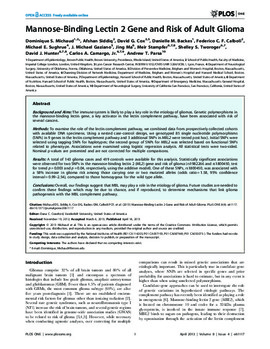| dc.contributor.author | Dominique S. Michaud | en_US |
| dc.contributor.author | Afshan Siddiq | en_US |
| dc.contributor.author | David G. Cox | en_US |
| dc.contributor.author | Danielle M. Backes | en_US |
| dc.contributor.author | Federico C. F. Calboli | en_US |
| dc.contributor.author | Michael E. Sughrue | en_US |
| dc.contributor.author | J. Michael Gaziano | en_US |
| dc.contributor.author | Jing Ma | en_US |
| dc.contributor.author | Meir Stampfer | en_US |
| dc.contributor.author | Shelley S. Tworoger | en_US |
| dc.contributor.author | David J. Hunter | en_US |
| dc.contributor.author | Carlos A. Camargo Jr | en_US |
| dc.contributor.author | Andrew T. Parsa | en_US |
| dc.date.accessioned | 2015-01-23T17:17:45Z | |
| dc.date.accessioned | 2016-03-30T15:36:12Z | |
| dc.date.available | 2015-01-23T17:17:45Z | |
| dc.date.available | 2016-03-30T15:36:12Z | |
| dc.date.issued | 2013-04-18 | en_US |
| dc.identifier.citation | Michaud DS, Siddiq A, Cox DG, Backes DM, Calboli FCF, et al. (2013) Mannose-Binding Lectin 2 Gene and Risk of Adult Glioma. PLoS ONE 8(4): e61117. doi:10.1371/journal.pone.0061117 | en_US |
| dc.identifier.uri | https://hdl.handle.net/11244/14093 | |
| dc.description | | en_US |
| dc.description | Collection of specimens in this study, including funding: JMG JM MS SST DJH CAC. Selection of genes and SNPs to include in the analysis: FCFC MES. Manuscript editing: DMB DGC MS SST CAC ATP. Conceived and designed the experiments: DSM ATP. Performed the experiments: AS. Analyzed the data: DSM AS DGC. Wrote the paper: DSM. | en_US |
| dc.description.abstract | Background and AimsThe immune system is likely to play a key role in the etiology of gliomas. Genetic polymorphisms in the mannose-binding lectin gene, a key activator in the lectin complement pathway, have been associated with risk of several cancers.MethodsTo examine the role of the lectin complement pathway, we combined data from prospectively collected cohorts with available DNA specimens. Using a nested case-control design, we genotyped 85 single nucleotide polymorphisms (SNPs) in 9 genes in the lectin complement pathway and 3 additional SNPs in MBL2 were tested post hoc). Initial SNPs were selected using tagging SNPs for haplotypes; the second group of SNPs for MBL2 was selected based on functional SNPs related to phenotype. Associations were examined using logistic regression analysis. All statistical tests were two-sided. Nominal p-values are presented and are not corrected for multiple comparisons.ResultsA total of 143 glioma cases and 419 controls were available for this analysis. Statistically significant associations were observed for two SNPs in the mannose-binding lectin 2 (ML2) gene and risk of glioma (rs1982266 and rs1800450, test for trend p = 0.003 and p = 0.04, respectively, using the additive model). One of these SNPs, rs1800450, was associated with a 58% increase in glioma risk among those carrying one or two mutated alleles (odds ratio = 1.58, 95% confidence interval = 0.99–2.54), compared to those homozygous for the wild type allele.ConclusionsOverall, our findings suggest that MBL may play a role in the etiology of glioma. Future studies are needed to confirm these findings which may be due to chance, and if reproduced, to determine mechanisms that link glioma pathogenesis with the MBL complement pathway. | en_US |
| dc.language.iso | en_US | en_US |
| dc.publisher | PLos One | en_US |
| dc.relation.ispartofseries | PLoS ONE 8(4):e61117 | en_US |
| dc.relation.uri | http://www.plosone.org/article/info%3Adoi%2F10.1371%2Fjournal.pone.0061117 | en_US |
| dc.rights | Attribution 3.0 United States | en_US |
| dc.rights.uri | https://creativecommons.org/licenses/by/3.0/us/ | en_US |
| dc.subject | PLOS | en_US |
| dc.subject | Public Library of Science | en_US |
| dc.subject | Open Access | en_US |
| dc.subject | Open-Access | en_US |
| dc.subject | Science | en_US |
| dc.subject | Medicine | en_US |
| dc.subject | Biology | en_US |
| dc.subject | Research | en_US |
| dc.subject | Peer-review | en_US |
| dc.subject | Inclusive | en_US |
| dc.subject | Interdisciplinary | en_US |
| dc.subject | Ante-disciplinary | en_US |
| dc.subject | Physics | en_US |
| dc.subject | Chemistry | en_US |
| dc.subject | Engineering | en_US |
| dc.title | Mannose-Binding Lectin 2 Gene and Risk of Adult Glioma | en_US |
| dc.type | Research Article | en_US |
| dc.description.peerreview | Yes | en_US |
| dc.description.peerreviewnotes | http://www.plosone.org/static/editorial#peer | en_US |
| dc.identifier.doi | 10.1371/journal.pone.0061117 | en_US |
| dc.rights.requestable | false | en_US |

